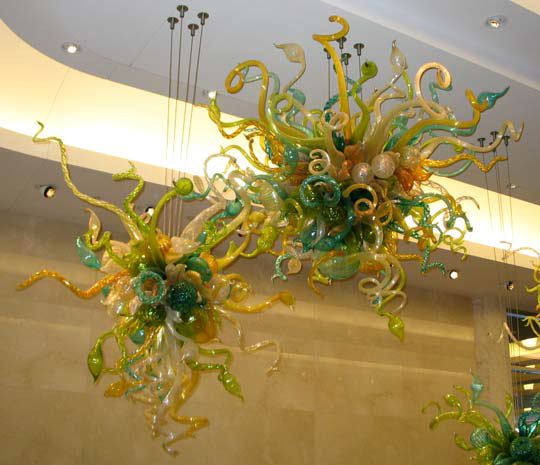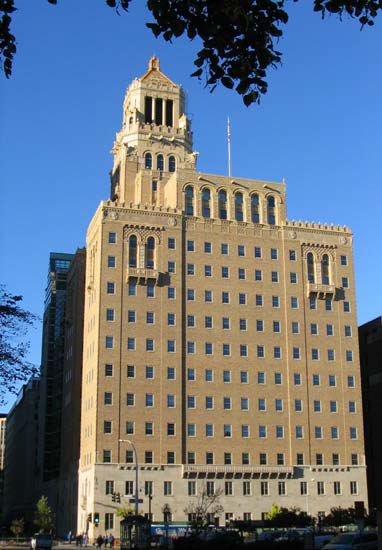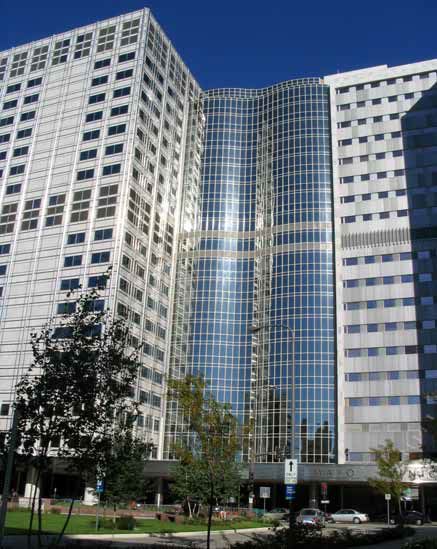To go Back at any time,
use Browser's "Previous Page"
Our short visit to Rochester and the Mayo Clinic can hardly be labeled comprehensive but it was very educational --- even eye-opening --- for us.
As with other lodgings near the Mayo Clinic, ours is linked to the Clinic buildings and to the closest hospital by subterranean walkway. We were told there are 4 and 1/2 miles of these subway tunnels all over the area! The one from our hotel to the Mayo Clinic, where we took in the 10 am tour, is nicely carpeted, pleasantly illuminated and air conditioned with suitably furnished alcoves here and there in which to rest, if needed. Moreover, there are many Skywalks linking medical center buildings and free shuttles to facilities farther away, such as St. Mary’s Hospital. Welcome touches in a region where winters can be harsh.
While we learned little about medical treatment details, what we did witness firsthand were superb patient/visitor amenities: artwork, flowers, sunlit atriums, beautiful marble floors and walls, attractive lounges and live piano music (like Nordstrom’s!). All of these, it is believed, are part of the healing process. The feeling that is generated is of a sparkling clean, friendly and most impressive medical facility.
The most spectacular piece of artwork we admired was the work of Dale Chihuly. This photo captures two of the thirteen glass “chandeliers”:

Collectively, these objects weigh a rather mind-boggling 6000 lbs, containing nearly 1400 different pieces of glass! Some people really like this unnamed artwork while others don’t --- probably depending on what they interpret the chandeliers to represent.
The tour, lasting almost two hours, included quite a bit of Mayo history. It began with a video on the lives of the Mayo brothers, Dr. Will and Dr. Charlie, as well as the influence of their mother and physician father. The evolution of the Mayo Clinic was told both by video and by the many historical artifacts in several buildings. By 1915, the brothers had established their Mayo Foundation which continues to this day, combining patient care with medical education and research. We learned of Dr. Henry Plummer who joined the Mayo brothers in 1901 and who is credited with the concept of a “Mayo Group Practice”. This innovative team approach to patient care has now become commonplace worldwide.
Dr. Plummer --- apparently, one smart cookie --- had strong interests and abilities in engineering and architecture as well as medicine. He is said to have been largely responsible for the architectural styling and functional layout of the Plummer Building (1929):

Of the many existing Mayo Clinic structures, the latest to be constructed is the Gonda Building, completed to 21 stories in 2001:

It has the interesting feature that 10 more floors can be added in the future when needed. The Hungarian-born couple who funded the building through their family foundation were concentration camp survivors. Eventually, they achieved incredible wealth living in Venezuela and later in the U.S.
As always, so much to see and so little time! On the way out of Rochester tomorrow, we’d like to tour more of this city than the part clustered around the medical center, attractive as that is. Our lodging tomorrow night will be in Prairie du Chien, WI, on the Mississippi River.